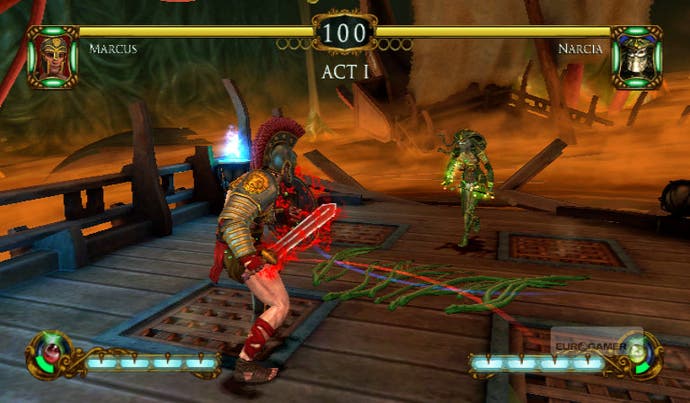Tournament of Legends
Maximus pain.
The structure of each battle is unorthodox, too. The first to three rounds wins. Win a round, and your remaining health carries over to the next, with just a short series of QTE inputs allowing you to fill the gauge slightly. Manage to take three rounds from your opponent before the clock runs down and you'll be victorious. But if the time runs out before you do, you'll be taken to a curious mini-game in which you rotate the analogue sticks in order to refill your health gauge and repair your character's armour.
The developer's over-reliance on stick-twiddling micro-games is carried over into battles themselves. Each arena is home to a different giant mythological creature - a Titan, Kraken or frost dragon, for example - that, at a random point during the battle, bursts in on the scene. An on-screen prompt gives you a couple of seconds to copy the displayed inputs. If successful, you'll dodge the beast's attack, while failure to do so will see your health bar depleted.
This awkward interruption would break the flow of battle - if there was one. But the system makes threading combos together difficult (indeed, anything above a three-hit string is deemed "epic" by the plum-voiced announcer). Likewise, while it's possible to block and quick-dodge, there's no true counter system, so fights have a staccato, unsatisfying rhythm that fails to flow or excite.

Once you have a grasp on the basic systems, it's an easy game, with only the final fight with Jupiter in Atlantis causing difficulties. Perhaps for this reason the developer failed to invest any effort into the Training mode, which offers nothing more than a short instructional video before dumping you into an arena with an enemy who cannot take damage. There aren't even any move lists to reference here, let alone any of the more useful training features that have been found in fighting games for nearly two decades now.
The game's 10 characters are divided into three different weight classes: lithe, rugged and massive. Each dictates the speed and power of the fighter, either fast and weak or slow and strong, with the most fun to be had with the faster characters that at least allow for some semblance of flow in lining together attacks.

A game with far fewer features than 3D fighters 15 years its senior, Tournament of Legends is an anachronism. Its back-of-the-box boasts of "massive 3D fighting" and "the opportunity to trade weapons and magic" sit somewhere between exaggeration and myth.
As a showcase for the Wii's technical abilities, the game is an embarrassment, graphically equivalent to those relics of 3D gaming's earliest days. And while the paucity of game modes would be forgiveable if those on offer sizzled with brilliance, in this context they bespeak a game rushed to completion and released with the very minimum of functional requirements. As a result, the only redeeming quality is the echo of ambition that can be faintly heard in the ruins of execution.








